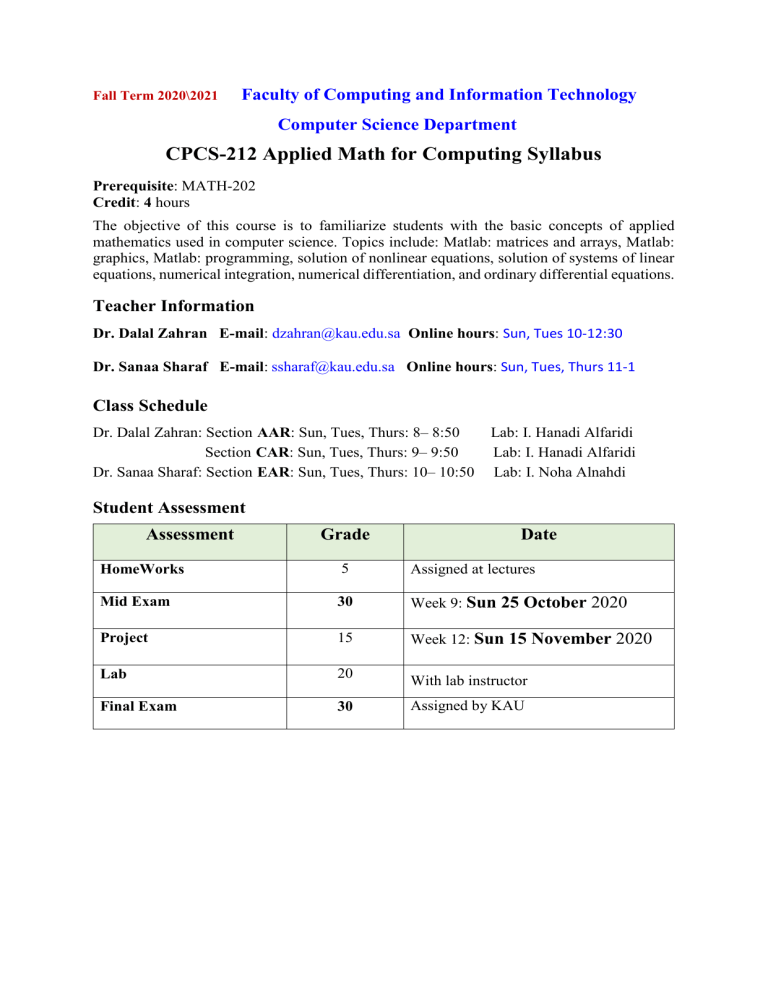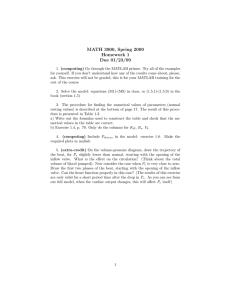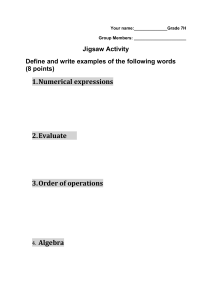
Fall Term 2020\2021 Faculty of Computing and Information Technology Computer Science Department CPCS-212 Applied Math for Computing Syllabus Prerequisite: MATH-202 Credit: 4 hours The objective of this course is to familiarize students with the basic concepts of applied mathematics used in computer science. Topics include: Matlab: matrices and arrays, Matlab: graphics, Matlab: programming, solution of nonlinear equations, solution of systems of linear equations, numerical integration, numerical differentiation, and ordinary differential equations. Teacher Information Dr. Dalal Zahran E-mail: dzahran@kau.edu.sa Online hours: Sun, Tues 10-12:30 Dr. Sanaa Sharaf E-mail: ssharaf@kau.edu.sa Online hours: Sun, Tues, Thurs 11-1 Class Schedule Dr. Dalal Zahran: Section AAR: Sun, Tues, Thurs: 8– 8:50 Section CAR: Sun, Tues, Thurs: 9– 9:50 Dr. Sanaa Sharaf: Section EAR: Sun, Tues, Thurs: 10– 10:50 Lab: I. Hanadi Alfaridi Lab: I. Hanadi Alfaridi Lab: I. Noha Alnahdi Student Assessment Assessment Grade Date HomeWorks 5 Assigned at lectures Mid Exam 30 Week 9: Sun 25 October 2020 Project 15 Week 12: Sun 15 November 2020 Lab 20 With lab instructor Final Exam 30 Assigned by KAU Textbook Applied Numerical Analysis, 7th ed. (2004), by Gerald & Wheatley, Addison-Wesley. Topics Coverage Rules and Regulations 1. Student is supposed to attend all online classes on time. Absence of 25% of total online classes without a genuine excuse will result in denied entry to the final exam, consequently the student will get DN (Denial) grade. 2. Lab attendance is mandatory. If you miss more than 25% of online labs, you will not be allowed to take the final lab exam. 3. Make-up exam is only for the student who submit a medical sick leave from a government or trusted hospital within 5 days after the missed exam. 4. Any makeup exam for an excused student will be held at the end of the term as appointed by the course instructors. It will include all chapters of the curriculum. 5. A zero (0) will be assigned for any cheating attempts on exam, homework, or project whether it is in the class or lab. 6. Exam Instructions: 1. Mid and Final exam: will be in KAU Campus. 2. Scientific calculator is prohibited (use very basic calculator: (+, -, *, /, ex). 3. Calculators are not allowed to be shared between examinees. 4. Write with a blue pen at the end of the exam. 7. It is your responsibility to check Blackboard regularly for announcements and posted updates. However, some clarifications may only be given in the class, so make sure you keep up with all announcements. 8. Use your KAU student e-mail only to communication with your course instructors and include your course number and section. 9. NO BONUS will be given in this course. Course Learning Outcomes By completion of the course the students should be able to: 1. Recognize basic data structures in Matlab. (a) 2. Recognize basic matrix mathematics in Matlab. (a) 3. State techniques for plotting data in Matlab. (i) 4. State programming fundamentals in Matlab (i) 5. *Calculate the roots using the idea of a numerical method (Bisection method, Newton method, Secant method) to locate roots of an algebraic equation. (a) 6. Apply a numerical method (Bisection method, Newton method, Secant method) to locate roots of an algebraic equation. (j) 7. Produce a program for a numerical method (Gaussian elimination method, Gaussian elimination with scaled partial pivoting method) to solve a system of linear equations in Matlab (i) 8. Apply a numerical method (Gaussian elimination method, Gaussian elimination with scaled partial pivoting method) to solve a system of linear equations. (j) 9. *Produce a program for a numerical method (Bisection method, Newton method, Secant method) to roots of an algebraic equation in Matlab. (i) 10. Apply a numerical method (Direct Interpolation And Least Square Regression ) to interpolate or curve fit discrete points (j) 11. *Apply a numerical method (Upper and lower sums, Newton-Cotes methods) to find the numerical integration of a function. (j) 12. Produce a program for a numerical method (Upper and lower sums, Newton-Cotes methods) to find the numerical integration of a function in Matlab. (i) 13. Apply a numerical method (difference method) to find the numerical differentiation of a function. (j) 14. *Produce a program for a numerical method (difference method) to find the numerical differentiation of a function. (i) 15. *Apply a numerical method (Euler method, Runge- Kutta method) to solve a differential equation. (j) 16. Produce a program for a numerical method (Euler method, Runge-Kutta method) to solve a differential equation in Matlab. (i)


